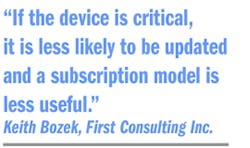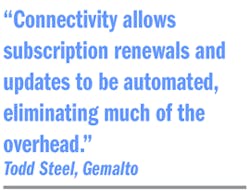It’s more common for engineers to suggest equipment or software than business strategies. But that might be changing, thanks to advanced systems. Just look at the many types of equipment on the market today. Some include various types of connectivity; others have advanced automation or robotics. Engineers might not realize that by selecting different equipment, they might also be choosing a business strategy. For example, new equipment might offer subscription options. In addition, the equipment may have options to upsell customers as upgrades or new software is available. This allows equipment to keep up with advancements and grow with the customer’s requirements. One of the most noted consumer examples was when Tesla Motors upgraded their vehicle software overnight to include autopilot.
While service agreements, warranties, and leases aren’t new to the automation field, there are some interesting developments in the manufacturing industry. Here, the ownership model is being challenged on multiple levels. “Connectivity makes subscriptions far easier to manage,” says Todd Steel, director of production management at Gemalto, a digital security and software monetization provider. “Connectivity allows subscription renewals and updates to be automated, eliminating much of the overhead that has discouraged many from adopting a subscription model in the first place.” Indeed, the Industrial Internet of Things (IIoT) has allowed more than just software to have a subscription model. If they get the option to monitor equipment, OEMs are more likely to enter rent or lease agreements. The following are three ways IIoT may be replacing the ownership model and providing additional service.
Level 1: Rent or Own
IIoT equipment and advanced automation may help smaller companies compete or enter new markets. However, not all companies can afford the high cost of advanced equipment. If a leasing option for such equipment is available, it may have benefits. The important part of this leasing or purchasing decision is basic engineering economics. Find the more cost effective option considering accrued interest, payments, and maintenance, compared to revenue generated with the equipment over the period of the lease or loan. It is important to remember that if you don’t own the equipment, you will not get to factor in the income from selling or scrapping it.
Another plus to the leasing model is that the owners of the equipment may take better care of it compared to post-purchase service agreements. The OEM also may offer upgrades or even replace old equipment as new equipment comes out. However, if the industry doesn’t change much or the equipment will be used for a long time, renting versus owning might defer back to basic economics.
When considering purchasing equipment, perform a general cost analysis to show if there is an optimal time to keep, sell, or upgrade equipment. In some cases, equipment lifecycle can last decades. So it is a relatively big decision. New technology will also drive this purchase or lease decision. If new advancements will be available in five years, but the optimum time to sell a piece of equipment is at seven years, your competition might have two years where they are able to outperform you simply based on a technology lag.
Ultimately, this first level of leasing IIoT or advanced automation equipment is for companies to gain access to tools or equipment that they might not be able to afford. In addition, this model could provide a testing ground for expensive tools and equipment to see if it’s worth the cost of ownership.
Level 2: The Subscription Model
IIoT connectivity will allow the OEM or service provider to enable or disable features based on what the user needs or is willing to pay. As a result, service providers will have to work hard to justify their costs. Having the ability to drop a service easily could lead to better customer service, but it may also mean longer and strict contracts. The IIoT market is expected to reach 123.89 billion by 2021, indicating a 21% capital annual growth rate from 2016 according to IndustryARC. Given such growth, the subscription model is expected to become a growing trend.
Many companies are concerned with building their products, not the growth of IIoT. But the IIoT is here to stay, which means there will be more equipment with additional features whether companies want it or not. If a company doesn’t find a benefit in some of the features, service agreements will have to offer an alternative or lose business.
Such a scenario is already happening in 3D printing, which means we may be able to learn some lessons from that market. Specifically, Stratasys and other high-end 3D printers offer customers the option to buy the equipment. But they have large maintenance packages to ensure customers machine are being run and maintained properly. Carbon 3D took another approach and is only offering a subscription model, allowing users to essentially rent the equipment. I have heard representatives from both companies say they will fix equipment in the field and perform upgrades as necessary, despite the customer being a renter or owner. Yet Carbon 3D added that if a customer has an old machine in the field, it will be replaced with the next model. A traditional manufacturer would provide maintenance, but only offer customers an option to buy the next model when it came out.
The big difference from 3D printing to IIoT equipment will be software and data management. Revenue from software and data management can become more profitable than the sale of equipment. This is leading some equipment manufacturers to start or expand services and subscriptions. In some industries, the aftermarket is the largest revenue stream. “The main benefit to a subscription base model is that it is a recurring revenue model, which provides vendors with the ability to offer more competitive pricing with lower entry costs for their customers,” notes Steel. “It also makes it much easier for consumers to scale up or down based on demand or capacity, which is especially important in the embedded industry.” Now, companies can buy the equipment while entering a service agreement or have the service worked into the cost of the rent or lease. This allows the use of expensive software or monitoring a purchaser may not have the resources to manage, but still wants the benefits of having.
After all, the trend in IIoT equipment is to collect as much data as possible, even if the user doesn’t need it. This information and the software or dashboards that process data can be leased as needed. “Control of data should be put in the user’s hands,” says Dr. Shipeng Li, CTO of IngDan, an online and offline service company. “The user owns the data and controls who or what device can access or use his or her data for how long. Above all, the system should fuse the data, HMI, knowledge, and services provided, by each IoT device.” Currently, it is generally accepted that the company that produced the data, not the OEM of the equipment, owns data from a machine.
It is important to prioritize what features and upgrades will provide the most value, which may break down into what is critical and non-critical. “Two things affect upgrades in manufacturing: risk to production and the complexity of the device,” explains Keith Bozek, senior software engineer at First Consulting Inc. “If the device is critical, it is less likely to be updated and a subscription model is less useful. This would be something like a temperature control or E-Stop.”
He continues, “A non-critical device is more like an IoT device that polls a sensor or a group of sensors for data. I might appreciate upgrades and/or an entire swap-out of similarly capable devices with new hardware. New IoT devices and network hardware upgrades are more frequent here. I think the subscription model works for software of these devices too. A manufacturing environment would need a selection mechanism to select what is updated on the device. For example, critical bug fixes could be pushed but new features would not.”
Level 3: One-Stop Shop
Currently, preventative or predictive maintenance is the low-hanging fruit for the IIoT. However, some companies are also using this enhanced connectivity for supply chain and inventory control. Inventory can be expensive and, depending on location, different tax laws are in effect. Cost and taxes have lead companies to limit inventory as much as possible in many manufacturing plants. With IIoT capability, they have tight and even automated control of large inventories.
Beyond inventory management, companies are beginning to expand the capabilities of the IIoT starting with CAD programs. Specifically, software companies like Autodesk, SolidWorks, Siemens and ePlan are becoming a one-stop shop. Not only can some of their software draft a model for you, but they work with other companies that provide a library of products. This can streamline design, as motors and parts are downloaded with specifications from a library and then dragged and dropped into place.
As a next step, companies are using the specs and mating features to operate the machine virtually through an animation feature. While animation has been available before, machines can now be tested before building them. The result is a neat and organized BOM for parts. If these programs have an IIoT feature, it is possible to order the parts too. In fact, it is possible to link an order’s BOM to an inventory management system. A system like this will indicate if there is enough inventory to fill the order. Then, if the programming allows, it can place an order for any missing inventory. This would provide complete IIoT coverage from design to production and logistics.
Clearly, the days when answering the simple question, “Buy or lease?,” are gone. That decision is only the first of many, thanks to the IIoT. With today’s advanced equipment and software, manufacturers can reduce downtime, provide service and features that might otherwise be unattainable, and streamline supply chains and inventory.




